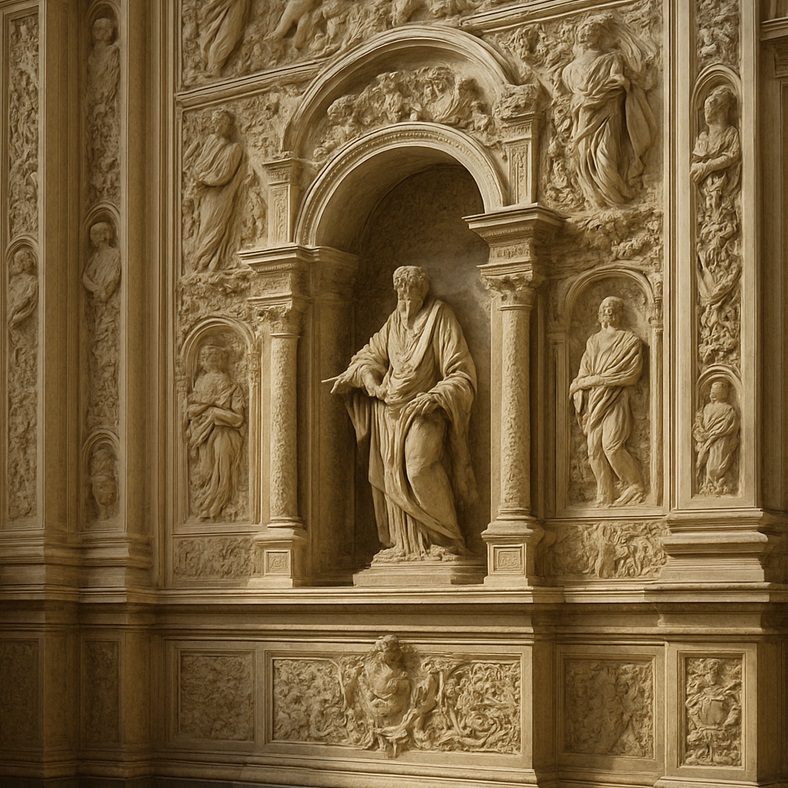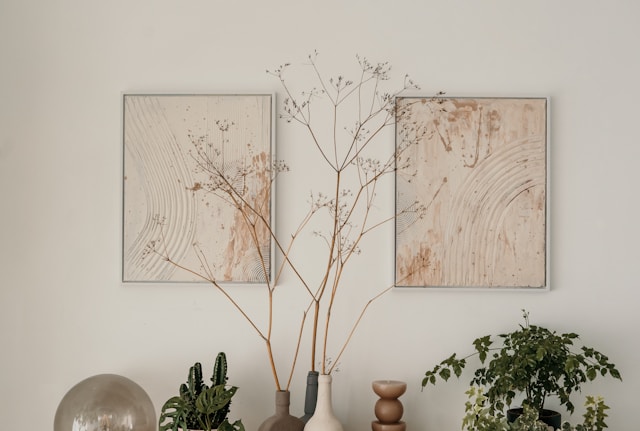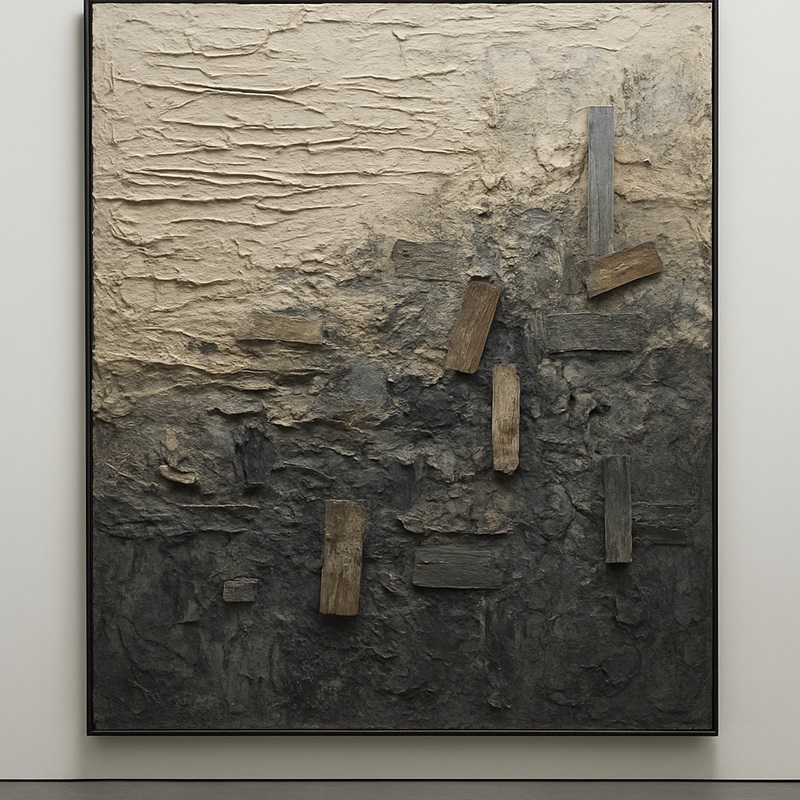Why Textured Wall Art Is Trending
In today’s homes, wall décor is more than flat photos or paintings. Many people now choose texture wall art—three-dimensional pieces that add depth and touchable detail.
From bold plaster designs to soft brushstrokes, textured art can turn plain rooms into lively spaces.
This trend isn’t only about style. Textured art changes with light and shadow, making a room feel alive and personal.
What Is Texture Wall Art?
Texture wall art focuses on surface depth and touch. Unlike flat prints, these pieces are made to be felt as well as seen.
Common Materials and Techniques:
- Paint Layers & Impasto – Thick paint creates raised surfaces.
- Plaster & Resin – Add sculptural shapes.
- Mixed Media – Fabrics, wood, or metal give contrast.
- Natural Elements – Sand, stone, or clay mimic nature.
Texture art fits many styles. It can look modern and bold, earthy and natural, or clean and minimal.
Why Textured Art Lasts
Flat prints can look the same every day. But textured art shifts with light and angle. A wave pattern may glow in the morning sun and look calmer at night.
This change keeps the art interesting over time.
Experts also note that textured visuals trigger stronger feelings. The depth invites curiosity and creates a grounded, sensory mood that flat art cannot match.

History of Texture in Art
Texture in art may feel modern, but it has shaped interiors for centuries.
During the Renaissance and Baroque eras, churches and palaces were full of detail. Their walls were not flat paint alone. They were carved with reliefs that played with shadow and depth. These designs turned sacred spaces into dramatic, immersive scenes.
Centuries later, the Impressionists gave texture new life. Painters like Vincent van Gogh broke from tradition. He applied paint so thickly that each brushstroke rose off the canvas. His impasto technique didn’t just show movement—it became movement. Skies swirled, and fields seemed to ripple before the viewer’s eyes.
In the 20th century, modern artists pushed texture further. Anselm Kiefer used industrial materials to create rough, fractured surfaces. His work reflected landscapes of memory and history. Frank Stella shaped canvases into sculptural forms, blurring the line between painting and architecture. His art gave walls a true three-dimensional presence.
Today’s textured wall art continues this tradition. It is not just décor but part of a long story. Each canvas carries echoes of palatial carvings, Van Gogh’s bold strokes, and the experiments of modern masters. For homeowners, textured art is more than design—it is a way to join a centuries-old dialogue between art, space, and human experience.
Choosing the Right Textured Art Canvas
When selecting textured wall art, consider the following:
- Scale & Proportion
- Large pieces: Ideal for open living rooms, lofts, or office lobbies.
- Medium pieces: Work well above sofas, beds, or fireplaces.
- Small canvases: Perfect for gallery walls, entryways, or hallways.
- Style & Atmosphere
- Abstract textures: Add energy and creativity.
- Nature-inspired motifs (waves, landscapes, organic patterns): Create a calming, grounded environment.
- Minimalist designs: Blend into modern, Scandinavian interiors.
- Color Coordination
- Neutral textured works pair with almost any scheme.
- Bold colors can serve as a focal point or anchor for the room.
Framed Textured Wall Art for a Polished Look
While raw edges can give a contemporary, studio-style feel, adding a frame instantly elevates the work.
- Black or White Frames: Sleek, modern look — best for minimalist interiors.
- Wood Frames: Warm, rustic, or bohemian appeal.
- Metallic Frames: Luxe, glamorous feel for upscale interiors.
Framing also protects the artwork, preventing wear and making it look more intentional in a curated setting.
How to Use Textured Art Canvas in Different Rooms
Living Room: Create a Focal Point
The living room is the best place for bold textured art. A large canvas above the sofa or fireplace quickly becomes the center of attention.
Pick bold abstract textures for modern homes. Choose nature-inspired designs for calm and balance. Add accent lighting to highlight the raised details so the art shifts with light during the day.
Dining Room: Add Elegance and Flow
Dining rooms look great with wide, horizontal textured pieces. These stretch the wall and add movement.
Neutral textures work well with simple dining tables. Metallic or gold-leaf accents bring extra elegance for formal dinners.
Bedroom: Promote Calm and Serenity
In bedrooms, textured art should feel soft and relaxing. Place a medium canvas above the headboard.
Choose neutral tones that match bedding and fabrics. Organic textures like waves, clouds, or plants add a soothing touch and make the space restful.
Entryway or Hallway: Set the Tone
The entryway gives the first impression of your home. A vertical canvas or a set of small textured pieces can guide the eye down a hallway.
Pick bold yet welcoming designs. Warm earth tones or geometric shapes make guests feel engaged right away.
Home Office: Inspire Creativity
In workspaces, textured art is both stylish and motivating. Abstract or geometric pieces spark creativity and keep walls from feeling flat.
Place one behind your desk. It creates a professional backdrop for video calls and shows off your style.
Placement & Styling Tips
Lighting
- Place textured art where natural or artificial light can highlight shadows.
- Use spotlights or wall washers to boost depth and dimension.
Pairing with Furniture
- Don’t overcrowd walls. Let big pieces breathe.
- Align artwork with the edges of furniture for balance.
- Group small pieces together to create gallery walls.
Common Mistakes to Avoid
- Hanging textured art too high. Keep it at eye level.
- Pairing very large art with small furniture, which looks unbalanced.
- Ignoring wall color. Textures look best against a contrasting backdrop.
Trends & Market Insights
The market for textured art is booming. Allied Market Research projects the global home décor market will reach $1 trillion by 2030, with wall art as a major driver.
Platforms like Etsy, Wayfair, and Instagram have made 3D wall art more accessible.
On social media, searches for “textured wall art” and “3D canvas art” have surged in the past three years. The growth is fueled by home renovation shows and influencer content.
Luxury developers also use large textured pieces in model homes to add sophistication.
Maintenance & Care of Textured Paintings
Unlike flat prints, textured art requires special care:
- Dusting: Use a soft brush or microfiber cloth; avoid rough wiping.
- Humidity Control: Keep away from damp areas to prevent warping.
- Sunlight Exposure: Limit direct UV to avoid fading or cracking.
- Professional Cleaning: For resin or mixed-media works, consult an art restorer every few years.
These steps ensure your artwork remains timeless and durable.
Alternatives & Comparisons
If textured art feels too bold, consider related options:
- Tapestries & Fiber Art – Softer, fabric-based textures.
- Wall Murals – Painted or wallpapered depth effects.
- 3D Panels – Architectural solutions for modern walls.
Highlighting alternatives broadens appeal and positions your article as a complete guide.
Final Thoughts: Bringing Texture into Your Home
Texture wall art offers more than surface beauty — it transforms how interiors feel and function. From modern lofts to cozy apartments, adding depth and dimension creates a personalized, ever-changing environment.
By choosing the right size, style, and placement — and by caring for your pieces properly — textured artwork can become not just décor but a timeless expression of personality and taste.





